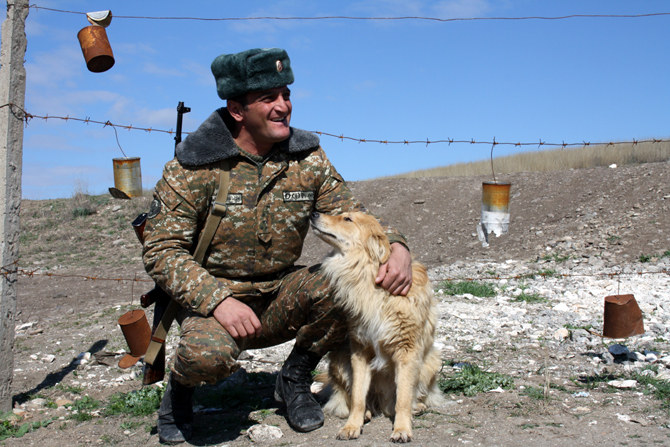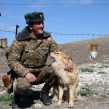
Possible Introduction of Russian Peacekeeping Forces Into Karabakh Opposed by Armenia
Publication: Eurasia Daily Monitor Volume: 12 Issue: 155
By:

A resolution of the “frozen conflict” between Armenia and Azerbaijan over the disputed Karabakh region—though internationally recognized as legally part of Azerbaijan—continues to slowly move forward. The question is what form it will take, and what outside powers will be most influential in promoting it. The Armenian press has recently been speculating about the outcome of the July 13 visit to Moscow of the United States’ co-chair of the Organization for Security and Cooperation in Europe (OSCE) Minsk Group, James Warlick, and his French counterpart (ArmeniaNow.com, July 23). Following the visit, Russian Foreign Minister Sergei Lavrov stated that the negotiations on the Karabakh problem should be intensified, leading many Armenian analysts to conclude that Russia wants to further insert itself into the peace process, perhaps by redrawing Karabakh’s frontiers and introducing Russian peacekeeping troops to this separatist territory.
One’s of the seemingly most intractable “frozen conflicts” in Eurasia is that between Azerbaijan and Armenia, who have been locked in a military and diplomatic stalemate over Karabakh for the past two decades. In February 1988, three years before the collapse of the Soviet Union, Armenia went to war with Azerbaijan over the disputed territory, with military operations lasting until May 1994, at a cost of 30,000 lives. A ceasefire brokered by Russia left Armenia in control of Karabakh and seven adjacent districts, approximately 20 percent of Azerbaijani territory, something that Baku has never accepted. A final peace treaty has not been signed and the two sides regularly trade accusations of cease-fire violations. For the past 20 years the “frozen conflict” has rebuffed all diplomatic efforts to resolve the dispute.
Last month, the OSCE Minsk Group co-chairs, Igor Popov of Russia, James Warlick of the United States, and Pierre Andrieu of France, traveled to Yerevan and Baku to meet with Armenian President Serzh Sargsyan and Azerbaijani President Ilham Aliyev in order to facilitate the settlement of the Karabakh conflict. Following the discussion, at a July 23 press conference, the Minsk Group delegation praised the willingness of the Azerbaijani and Armenian presidents to meet later this year (Trend, July 23).
Many Armenians, including government officials, see Russia’s sudden interest in the peace negotiations between Armenia and Azerbaijan as self-serving. Anush Sedrakyan, the deputy chairman of the Armenian opposition party Free Democrats, stated that Russia’s goal is actually to seek increased influence in the South Caucasus. Moreover, she openly argued against the wisdom of the widely repeated suggestion that Moscow may want to introduce Russian peacekeepers into Karabakh. As she pointed out, Russia is arming both sides in the conflict, and has been for years. According to Sedrakyan, Armenia—which sees Russia as a military and political partner in the framework of the Collective Security Treaty Organization (CSTO) as well as bilateral Armenian-Russian relations—is increasingly concerned about Moscow’s sale of modern offensive weaponry to Azerbaijan, flush with oil export cash (Deutsche Welle–Russian service, August 8).
Indeed, according to the official 2013 report of the Russian Federation in the UN Register of Conventional Arms, Russia has supplied Azerbaijan with 10 tanks, 10 infantry fighting vehicles (IFV), 438 various artillery systems and 25 combat helicopters. At the same time Russia supplied Armenia, with 35 tanks, 110 IFVs, 50 rocket launchers and 200 missiles (Un-register.org, accessed August 31). Russia supplies arms to Armenia usually at reduced rates, as both countries are members of the CSTO.
At the same time, the Global Militarization Index 2014 study, published by the Bonn International Center for Conversion (BICC), notes that Armenia and Azerbaijan are among the top ten countries with the highest levels of militarization in the world, with Armenia ranking third and Azerbaijan tenth in the index (Bicc.de, accessed August 31). In 2013, Armenia’s military expenditures totaled $427 million, while expenditures in Azerbaijan grew to $3.4 billion, fueled by the two countries’ focus on the Karabakh conflict. In Armenia, military expenditures represent 4 percent of its GDP; in Azerbaijan it is 4.7 percent.
While international peacekeepers in Karabakh might, at the very least, reduce the number of border incidents, Russian peacekeepers could introduce a “wild card” element. After all, on August 7, 2008, the shelling of Russian peacekeepers in Tskhinvali, South Ossetia, was used as a casus belli for the ensuing five-day Russian-Georgian war, which resulted in Georgia’s territories of South Ossetia and Abkhazia coming under Russian occupation.
If Armenia sees Russia playing a double game in the South Caucasus, Azerbaijan sees covert forces involved in the Karabakh conflict, potentially underwritten by the influential Armenian lobby in the United States. In February, Novruz Mammadov, the deputy head of Azerbaijan’s presidential administration and chief of the Foreign Relations Department, said, “The US directly supports the separatist regime in Karabakh. It realizes its sanctions policy in similar situations in other parts of the continent, while [it] bans its financial bodies from any activity in the mentioned territories” (Azernews, February 4). In the meantime, the heated rhetoric and number of border incidents continues to rise, raising concerns in Europe.
President of the European Council Donald Tusk said on July 22, during a joint press conference with Aliyev in Baku, “It’s clear for me and for the [European Union] that the status quo is in fact unacceptable. I was very clear also in Yerevan two days ago. […] I think that today we need to avoid not only military actions but also radical language and aggressive rhetoric. We have to avoid this rhetoric because war and hot conflicts—this is the last thing we need,” adding that the situation in Ukraine exemplified the best of the worst of this kind of politics and also ideology of aggression (Trend, July 22).
Peace talks mediated by Russia, France and the US through the OSCE Minsk Group are underway on the basis of a peace outline proposed by the Minsk Group co-chairs—the so-called “Madrid Principles.” The negotiations have been largely fruitless so far, and the UN Security Council’s four resolutions on Armenian withdrawal have yet to be enforced. Currently, for Russia, the status quo is best: no peace, no war. But Russia remains the wild card, as Putin may be tempted covertly to provoke fighting in order subsequently to deploy peacekeepers, thereby gaining leverage and consolidating Moscow’s influence in the South Caucasus. What is significant is that the conflict is drawing Europe’s attention; whether European policies will be able to ameliorate the situation remains to be seen.




